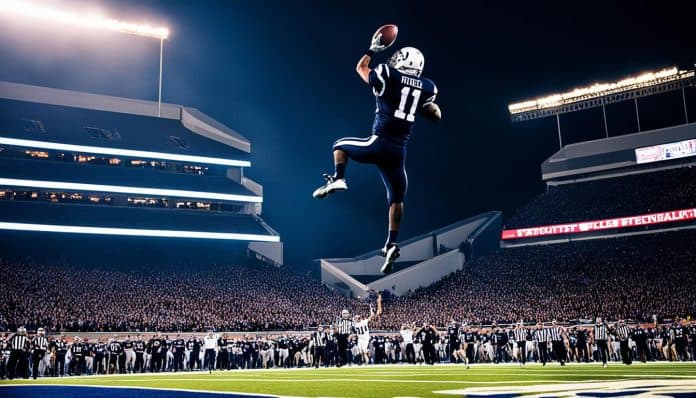In American football, FNL means “Friday Night Lights.” It’s about high school football games on Friday nights. This all comes from the famous book, movie, and TV show “Friday Night Lights.” FNL shows the big role high school football plays in the culture of the U.S.
“Friday Night Lights” is more than a story about football. It shows the strong bond between the game, community, and tradition. FNL brings people together and celebrates local pride all over America, especially during football season.
This meaning of FNL is about more than just games. It’s about the connection it brings among students, parents, and past students. Embracing FNL helps us understand its significant place in American football culture.
Key Takeaways
- The term FNL stands for “Friday Night Lights,” reflecting more than just a game but a cultural rally point.
- FNL events are significant in shaping the communal spirit and are a cornerstone of high school experiences in America.
- The origin of FNL comes from a popular book that spotlighted the intense high school football culture in Odessa, Texas.
- FNL underscores the deep-seated tradition of football in American society, particularly at the high school level.
- Through films and TV series, FNL has broadened its influence, becoming a staple in discussions about American football.
- Understanding FNL is essential for comprehending the broader narrative of community and identity in American football.
Unveiling FNL: The Acronym in the Heart of American Football Culture
The term “Friday Night Lights” (FNL) is more than words. It’s a big part of American high school football culture. It started as a loved event where people came together at local stadiums. There, they cheered the players who represented more than just a team. They showed communal pride and spirit.
The Roots of the FNL Phenomenon
In 1990, H.G. Bissinger wrote a book called Friday Night Lights: A Town, a Team, and a Dream. This book put Odessa, Texas under the spotlight, sharing its intense football culture. Through his work, Bissinger showed how football influenced Odessa’s community deeply. Since then, FNL has grown into a big American tradition, proving how sports shape our values and connections.
FNL and American High School Spirit
The acronym FNL captures the remarkable high school football game environment. It’s a mix of young sports talent and community unity. Such events boost school and town spirit, connecting students, teachers, parents, and graduates. FNL’s impact is felt in every game and cheer, making high school memorable and uniting locals in support and belonging.
Impact of ‘Friday Night Lights’ on Community Traditions
Bissinger’s book turned into a movie and famous TV series, spreading FNL across the U.S. This made many other places adopt FNL-like traditions. It strengthened the role of high school football in American life. These traditions bring people together, help local businesses, and create lasting memories.
FNL isn’t just about sports. It’s about blending personal success with community connections, leaving a lasting influence with each new generation.
From Page to Screen: The Legacy of ‘Friday Night Lights’
In 1990, H.G. Bissinger wrote the Friday Night Lights book. He showed the true life of high school football in Odessa, Texas. The book’s realness touched many people and showed how sports can affect a whole community. It was so well liked, others wanted to do more with its story.

A big step in sharing the story was the movie adaptation in 2004. Peter Berg directed Friday Night Lights, starring Billy Bob Thornton. This movie made the Odessa Permian Panthers’ tale global, making people feel its drama on the big screen.
The success led to the TV series in 2006. It took the story deeper, over five seasons. This show became very popular, making viewers care about the characters even more. It was loved by both fans and critics for its detailed look at life in small-town Texas.
| Year | Medium | Impact |
|---|---|---|
| 1990 | Book | Established core story and themes |
| 2004 | Movie | Expanded audience, added visual depth |
| 2006-2011 | TV Series | Broadened narrative, deepened character development |
The Friday Night Lights book, movie adaptation, and TV series keep inspiring people. They remind us of the importance of community, hard work, and finding ourselves. Each version added something special to the story, making it a lasting part of culture.
What Does FNL Mean in Football?
In American sports, “FNL” has a special meaning, especially in high school football. “FNL” means “Friday Night Lights.” It shows the spirit of small towns. Here, high school football games happen on Friday nights. This brings the community together.
Friday Night Lights mean much more than just games. It’s about community and pride. In many towns, Fridays become a time for everyone to come together. It’s a celebration under the stadium lights. People from all over the community gather to support their team.
So, “FNL” stands for more than just three letters. It symbolizes a coming together each week. This event is a big part of American culture. It’s about sport, fun, and being part of something larger. Each Friday night, FNL shapes communities all over the country.
























































